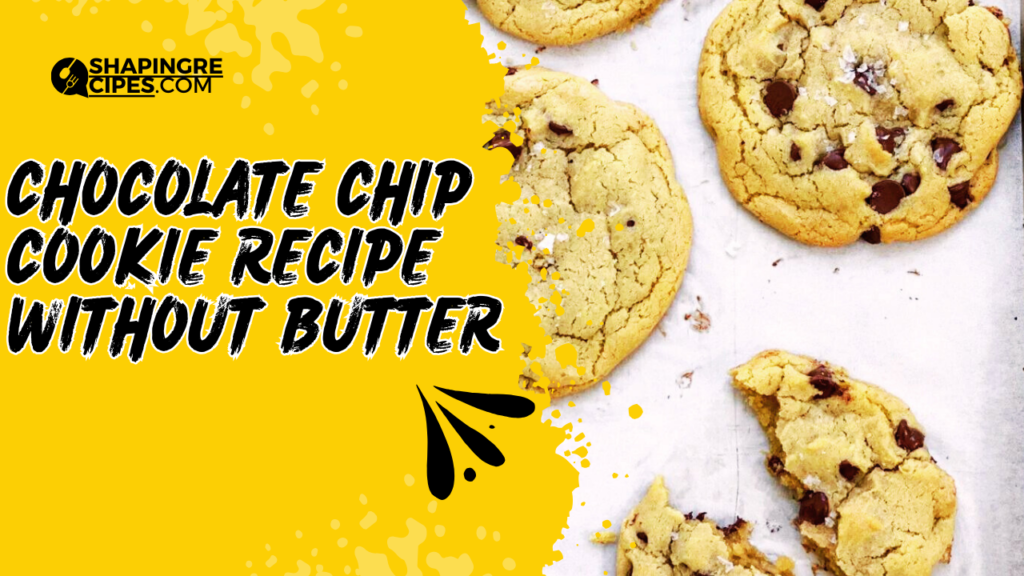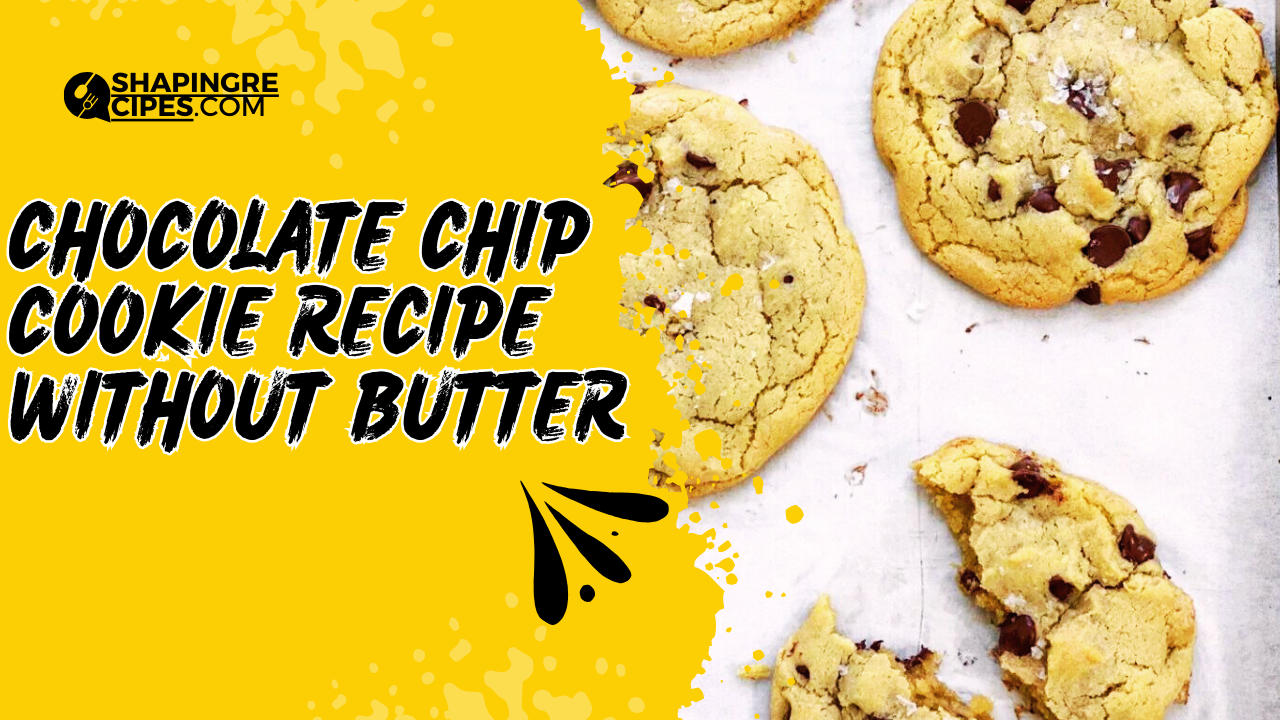
In today’s post, we are going to tell you about Chocolate Chip Cookie Recipe Without Butter.When it comes to baking, chocolate chip cookies are an undisputed favorite. However, not everyone has butter readily available or can’t eat it due to dietary restrictions. This comprehensive guide will walk you through an exceptional chocolate chip cookie recipe without butter that doesn’t compromise on flavor or texture. The result? Chewy, crispy, and satisfying cookies you’ll want to bake again and again.
Why Bake Without Butter?
Butter is often a go-to ingredient in baking due to its rich flavor and ability to create a tender crumb. However, there are several reasons why one might opt to bake without it. Some people are lactose intolerant, while others may be watching their cholesterol levels or following a vegan diet.
Additionally, you might simply run out of butter and still crave homemade cookies. Fortunately, plenty of substitutes can achieve similar, if not better, results.
The Perfect Butter Substitute
In this recipe, we use coconut oil as our primary substitute for butter. Coconut oil has a similar fat content to butter, ensuring the cookies maintain that rich, satisfying flavor. Additionally, it adds a subtle hint of coconut, which pairs beautifully with the chocolate chips.
Other suitable substitutes include:
*Olive Oil: Provides a slightly fruity flavor, perfect for a Mediterranean twist.
*Vegetable Oil: A neutral-flavored oil that won’t overpower the taste of your cookies.
*Applesauce: Great for a lower-fat option, though it will result in a softer, more cake-like texture.
*Greek Yogurt: Adds moisture and a slight tang, but use the plain variety to avoid altering the flavor profile.
Ingredients for chocolate chip cookie recipe without butter
- 2 1/4 cups all-purpose flour
- 1 tsp baking soda
- 1/2 tsp salt
- 1/2 cup coconut oil, melted
- 3/4 cup granulated sugar
- 3/4 cup brown sugar, packed
- 2 large eggs
- 2 tsp vanilla extract
- 2 cups semisweet chocolate chips
Step-by-Step Instructions
1. Preheat Your Oven
Preheat your oven to 350°F (175°C). This ensures your cookies bake evenly and achieve the perfect golden-brown color.
2. Mix Dry Ingredients
In a medium bowl, whisk together the flour, baking soda, and salt. This step is crucial for distributing the leavening agent evenly throughout the dough, resulting in cookies that rise evenly.
3. Combine Wet Ingredients
In a separate large bowl, beat together the melted coconut oil, granulated sugar, and brown sugar until well combined. The sugars will dissolve slightly, creating a smooth base for your cookies. Add the eggs one at a time, beating well after each addition. Finally, mix in the vanilla extract, which enhances the overall flavor profile of the cookies.
4. Incorporate Dry Ingredients into Wet Mixture
Gradually add the dry ingredients to the wet mixture, mixing just until combined. Be careful not to overmix, as this can result in tough cookies. The dough should be soft but not too sticky.
5. Add Chocolate Chips
Fold in the chocolate chips, ensuring they are evenly distributed throughout the dough. This ensures each bite is packed with chocolatey goodness.
6. Shape the Dough
Using a cookie scoop or a tablespoon, drop rounded balls of dough onto a baking sheet lined with parchment paper. Be sure to space them about 2 inches apart, as the cookies will spread as they bake.
7. Bake
Bake in the preheated oven for 10-12 minutes, or until the edges are golden brown and the centers are set. The key to perfect cookies is to slightly underbake them, as they will continue to firm up as they cool on the baking sheet.
8. Cool and Enjoy
Allow the cookies to cool on the baking sheet for 5 minutes before transferring them to a wire rack to cool completely. This ensures they maintain their shape and achieve the perfect texture.
Tips for Success
- Use Room Temperature Ingredients: Eggs should be at room temperature to mix more easily with the other ingredients, resulting in a smoother dough.
- Chill the Dough: For thicker cookies, chill the dough for 30 minutes before baking. This will prevent them from spreading too much in the oven.
- Experiment with Add-Ins: While chocolate chips are classic, feel free to experiment with other add-ins like nuts, dried fruit, or even white chocolate chips for a twist.
Storing Your Cookies
Once baked, these cookies can be stored in an airtight container at room temperature for up to a week. For longer storage, consider freezing them in a single layer on a baking sheet before transferring them to a freezer-safe bag. They will keep for up to three months and can be enjoyed straight from the freezer or after a quick warm-up in the microwave.
Final Thoughts
Baking chocolate chip cookies without butter doesn’t mean sacrificing flavor or texture. By carefully selecting a butter substitute like coconut oil, you can create cookies that are just as delicious as the traditional version, with a unique twist. Whether you’re baking for dietary reasons or just want to try something new, this recipe is sure to become a favorite in your home.
FAQs
1. Can I use olive oil instead of butter in chocolate chip cookies?
Yes, olive oil can be used as a butter substitute, but it imparts a distinct flavor. It’s best used in recipes where a savory touch is desirable.
2. What is the best substitute for butter in chocolate chip cookies?
Coconut oil is one of the best substitutes due to its similar fat content and ability to create a chewy texture. It also adds a pleasant, subtle sweetness.
3. How do I make vegan chocolate chip cookies without butter?
To make vegan cookies, use a plant-based oil (like coconut or vegetable oil) and replace the eggs with flaxseed meal or a commercial egg replacer.
4. Why are my butter-free cookies not spreading?
If your cookies aren’t spreading, the dough may be too cold, or you may have used too much flour. Ensure your dough is at room temperature before baking, and measure your ingredients carefully.
5. Can I make these cookies gluten-free?
Yes, you can substitute the all-purpose flour with a gluten-free flour blend. Be sure to use a blend that includes a binding agent like xanthan gum for the best results.
